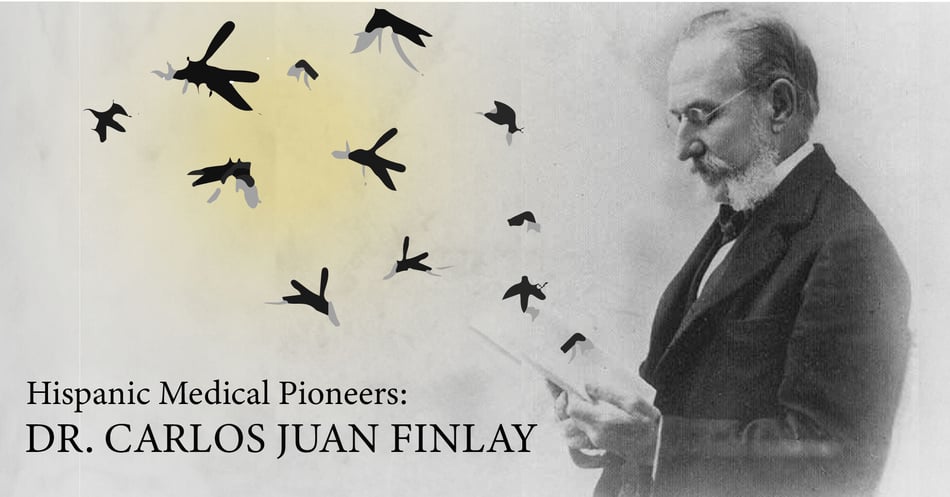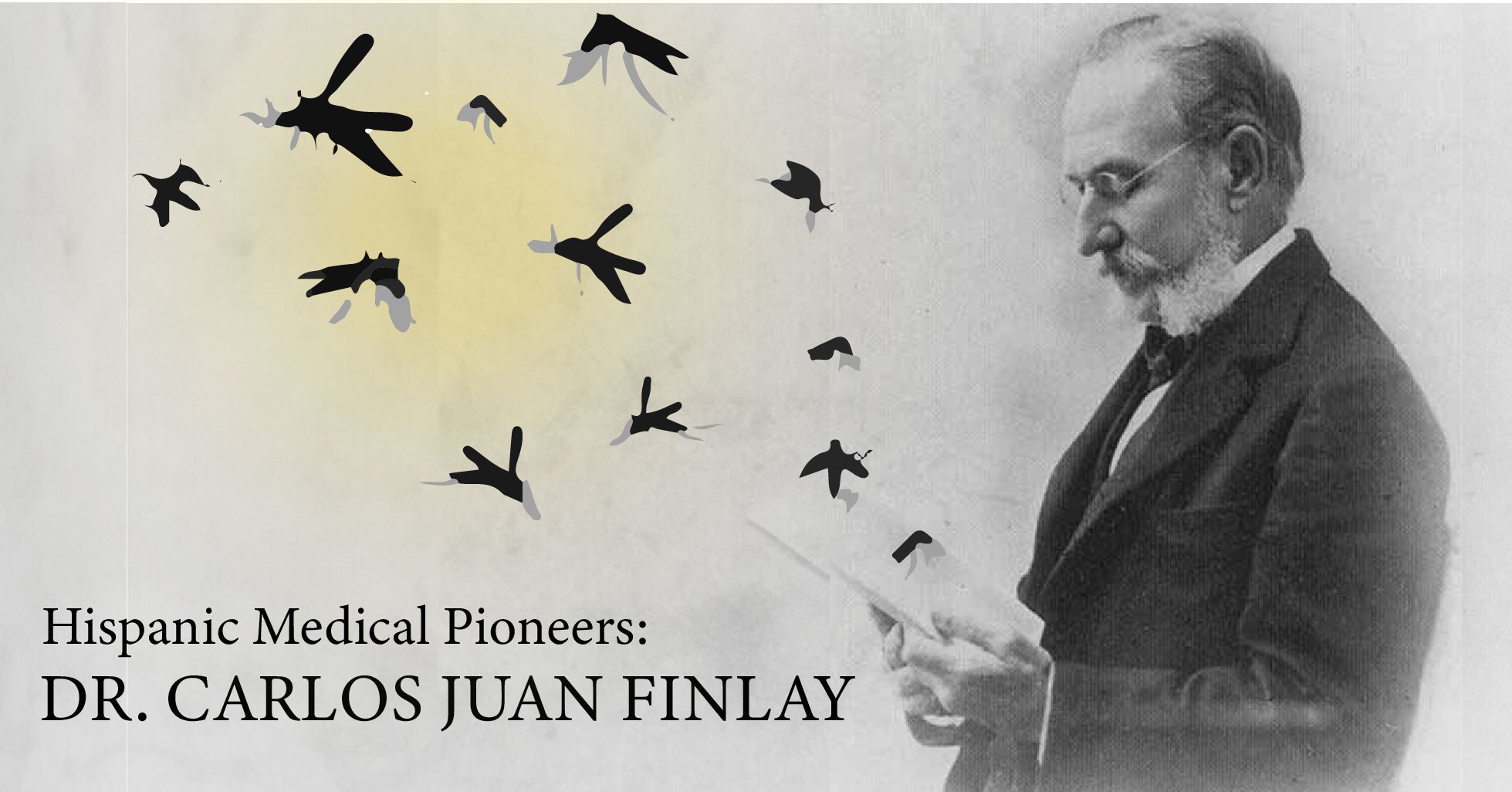Hispanic Medical Pioneers: Dr. Carlos Juan Finlay

 There are countless contributors to the world of medicine who share Hispanic/Latino backgrounds, but there are a few noteworthy individuals whose work has been instrumental in advancing the fields of epidemiology and infectious disease prevention and treatment. In today's post, we will look at one of those key figures and his vital scientific legacy, Dr. Carlos Juan Finlay.
There are countless contributors to the world of medicine who share Hispanic/Latino backgrounds, but there are a few noteworthy individuals whose work has been instrumental in advancing the fields of epidemiology and infectious disease prevention and treatment. In today's post, we will look at one of those key figures and his vital scientific legacy, Dr. Carlos Juan Finlay.
A young Scottish medical student joins a British expeditionary force to a warring Venezuela in the 1820s, becoming shipwrecked thousands of miles from home. He manages to stay alive and finds his way to a port on Trinidad. where he decides to stay and practice medicine. He marries and has a son, and soon moves to to Havana, Cuba. That son, Carlos, would grow up to solve one of the most deadly medical mysteries of his native island as well as the globe: The spread of yellow fever.
| What is Yellow Fever? Spread by infected mosquitos, yellow fever is a viral RNA infection that has a 20-50% mortality rate, depending on severity. It originated in Western Africa, and like many viral infections, was brought to the New World in the 1600s. It can cause symptoms that mimic the flu, as well as far more serious conditions such as liver failure and severe hemorrhage. Outbreaks of yellow fever used to routinely kill hundreds of thousands of people at a time, and outbreaks were frequent. Due to mosquito mitigation efforts and a vaccine, that death toll has been reduced to 30,000 deaths per year. However, this number could be zero if eradication efforts were funded in the most vulnerable locations. |
Carlos had just the right combination of personal experience and educational exposure to have the drive to discover the source of this infectious disease. He overcame illness and disability himself, including a communication disorder and a bout of typhoid. Due to these conditions as well as geopolitical changes, Carlos suffered enough setbacks in his education and professional life to leave him with a well-developed determination. These experiences helped give his medical studies purpose when he arrived in Philadelphia in the 1850s to study at Jefferson Medical College under professors who, rare at the time, fully accepted the germ theory of disease. There he learned that for every illness, there was a discrete cause from the environment itself. He graduated in 1855 and returned to Cuba with the intent to practice medicine.
Unfortunately, the oral exam required to transfer his degree from the United States (then considered a second-rate medical degree at best), did not go well due to his communication disorder as well as his English-only training. Undeterred, Carlos decided to travel with his father, a physician, and continue his education in the field. Nothing could stop his unquenchable intellectual curiosity, or his determination to pass that oral exam. He successfully completed the requirements in 1857.
Once Dr. Finlay established his practice and was accepted into the Royal Academy of Medical, Physical, and Natural Sciences of Havana, he began decades of productive work across a variety of medical topics, including bacteriologic laboratory design, cholera, tetanus, and of course, yellow fever. He was appointed to work with the US National Health Board Yellow Fever Commission in 1879 (formed right after the deadly Yellow Fever Outbreak of 1878), helping conduct data collection and experimentation on possible causes and treatments. The Commission determined that "the agent capable of transmitting the disease must be in the air," but had nothing more to add.
Finlay was not satisfied. He continued the Commission's line of inquiry, reviewing decades of data and building a theory upon his knowledge of germ theory. His research demonstrated three facts: 1) Yellow fever was spread only under certain weather and geographic conditions, 2) Transmission of yellow fever was not patient-to-patient, either from touching or secretions, and 3) The condition of blood vessels in infected patients pointed to the blood being the source of the infectious agent. He concluded that this agent had to be introduced into the blood, directly from another source of fresh blood, leading him to make the leap to a blood-sucking insect. He narrowed down the choices by investigating how these insects bit, the mechanisms behind their bite, how temperature and altitude affected their ability to bite, and numerous other considerations. Ultimately, his research pointed to the species of mosquito now known as Aedes aegyptii, which met all the criteria.
He was confident of his results, but still hesitant to share them with the general public. At that time, the idea of an animal, let alone a lowly insect, as the vector of a disease that killed millions was absolutely unknown. Only after he received permission to run human trials and had promising results did he report his findings to the Royal Academy. And... silence. In fact, Finlay was even met with some ridicule and mockery. Needless to say, nothing was done to act on these findings. Like many before him (John Snow, Ignaz Semmelweis, and more), his research was ignored.
Dr. Finlay's ideas would not be accepted (despite hundreds of experiments) until the 1900s, when the US Army Yellow Fever Board visited his lab and provided the needed external validation. (The person at the head of this board? None other than Walter Reed, for whom the Army's flagship medical center is named.) From these findings, the US Army was able to reduce yellow fever outbreaks simply by reducing exposure to mosquitos, through use of repellant, mosquito nets, and removing still water access. These efforts were successful, helping save lives until 1938, when a vaccine was developed by Max Theiler.
Dr. Carlos Finlay never stopped researching and publishing. Hewent on to serve as chief sanitary officer of Cuba, found ways to reduce infant mortality, and worked to eradicate cholera. But it is his work to discover of the vector of yellow fever has helped save millions upon million of lives worldwide.
![EOScu Logo - Dark - Outlined [07182023]-01](https://blog.eoscu.com/hubfs/Eoscu_June2024/Images/EOScu%20Logo%20-%20Dark%20-%20Outlined%20%5B07182023%5D-01.svg)




